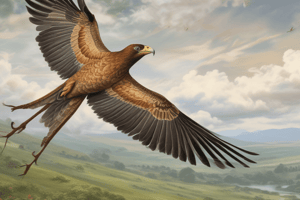Podcast
Questions and Answers
What literary device is used in the phrase 'dapple-dawn-drawn Falcon' to create a sense of the falcon's appearance?
What literary device is used in the phrase 'dapple-dawn-drawn Falcon' to create a sense of the falcon's appearance?
Compound words
What poetic technique is used in the line 'Of the rolling level underneath him steady air, and striding / High there how he rung upon the rein of a wimpling wing' to focus on the bird's flight?
What poetic technique is used in the line 'Of the rolling level underneath him steady air, and striding / High there how he rung upon the rein of a wimpling wing' to focus on the bird's flight?
Enjambment
What is the effect of the use of ellipsis in the first line of the poem 'I caught this morning morning's minion...'?
What is the effect of the use of ellipsis in the first line of the poem 'I caught this morning morning's minion...'?
It captures the poet's excitement
What literary device is used in the phrase 'off, off' and what effect does it create?
What literary device is used in the phrase 'off, off' and what effect does it create?
What is the poet's realization about the 'plod' or mundane work and effort in the final lines of the poem?
What is the poet's realization about the 'plod' or mundane work and effort in the final lines of the poem?
Flashcards are hidden until you start studying
Study Notes
The Windhover by Gerald Manley Hopkins
Themes and Ideas
- The poem explores the beauty of creation and the majesty of the natural world through the imagery of a windhover or falcon
- Celebrates the natural world and mankind's connection with nature
- Displays God's divine power and nature as a restorative force
Style
- Intensely detailed imagery is used to describe the windhover
- Complex language and compound-words like "dapple-dawn-drawn" create vivid descriptions
- Euphonic sound effects and caesura are used to capture the poet's excitement and emotion
- Enjambment is used to continue the focus on the windhover's movement and flight
Imagery and Symbolism
- The windhover represents the beauty and power of nature
- The repetition of "morning" creates movement and emphasizes the bird's royal nature
- "Dapple-dawn-drawn" describes the bird's appearance and connection to the natural world
- The simile "As a skate's heel sweeps smooth on a bow-bend" compares the windhover's flight to a smooth, curved motion
Poetic Devices
- Anadiplosis is used in "off, off forth on swing" to create a sense of movement and energy
- Enjambment is used throughout the poem to create a sense of flow and continuity
- Caesura is used to add drama and emotion, such as in "In his ecstasy!"
- Hyperbole is used to emphasize the speaker's wonder and admiration for the windhover
Analysis
- The poem is dedicated to "Christ Our Lord", emphasizing the idea that the windhover is a creation of God
- The speaker's admiration for the windhover is not just about its beauty, but also about the sense of wonder and awe it inspires
- The poem ends with a sense of transformation and renewal, as the "blue-bleak embers" burst forth in a golden-red color.
Studying That Suits You
Use AI to generate personalized quizzes and flashcards to suit your learning preferences.




